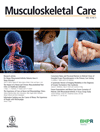Conversion Rates and Perceived Barriers to Referral: Views of Extended Scope Physiotherapists in the Primary Care Setting
Abstract
Aims
A questionnaire survey of primary care musculoskeletal extended-scope physiotherapists (ESPs) was undertaken to determine information about their conversion rates and referral barriers, with regard to radiological and consultant referrals.
Method
A sample of 200 musculoskeletal ESPs classified as having a speciality in orthopaedics and working in primary care were recruited via the ‘ESP Professional Network’.
Results
A total of 100 (50%) responses were received. Forty-seven per cent of primary care ESPs indicated that they recorded their conversion rates, but only 31 participants submitted conversion rate data. Overall, the average conversion rate for all participants was 74% (range 30–95%). Forty-three per cent of respondents identified that they had experienced barriers when referring for radiological investigations and 38% that they experienced barriers when referring patients to secondary care for a consultant opinion. Commissioning barriers such as poorly commissioned care pathways were the most common theme in both areas. Fifty per cent of respondents identified that they used a referral criteria when referring patients to secondary care. Commonly, these criteria had been developed in conjunction with secondary care consultants or commissioners.
Conclusion
ESPs in primary care have reported similar conversion rates to those working in secondary care. There is a need for further empirical conversion rate studies in primary care to validate these self-reported findings and to enable ESPs to demonstrate clinical efficiency and benchmark their performance. Copyright © 2012 John Wiley & Sons, Ltd.




